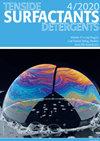Synthesis of non-ionic surfactants nano-vesicles for clarithromycin oral delivery
IF 1.2
4区 工程技术
Q4 CHEMISTRY, APPLIED
引用次数: 0
Abstract
Abstract In order to improve the solubility and bioavailability of poorly water-soluble drugs, the synthesis of cost-effective nonionic surfactants has been the subject of greater scientific interest. The present study focuses on the synthesis of sulfonyl chloride derivatives as nonionic surfactants (surfactant 1 and surfactant 2) and their evaluation for the preparation of a clarithromycin-loaded niosomal drug delivery system. Surfactants 1 and 2 were characterised by EI-MS and 1H NMR spectroscopy. The shape and size of the drug-loaded niosomal vesicles from the synthesised surfactants were examined by atomic force microscopy (AFM) and revealed a round morphology with an average size of (230.8 ± 2.35) nm and (248.1 ± 2.54) nm for the vesicles of surfactant 1 and surfactant 2, respectively. The zeta potential of surfactant 1-based niosomal vesicles was (– 7.70 ± 1.00) mV and that of surfactant 2 was (−14.6 ± 1.08) mV. The lower zeta potential values for surfactant 1 and surfactant 2-based niosomal vesicles showed that these vesicles were neutral and relatively stable. The vesicles of surfactant 1 and 2 have a capacity to entrap the drug of about (62 ± 2.26) % and (69.67 ± 3.23) %, respectively. The vesicles of surfactant 1 released the largest amount of drug, i.e. (70.00 ± 2.45) % at pH 1.2. Biocompatibility in human blood and toxic effects on various cell lines were also studied for surfactants 1 and 2, and they were found to be biocompatible and non-cytotoxic.口服克拉霉素非离子表面活性剂纳米囊泡的合成
摘要为了提高水溶性差的药物的溶解度和生物利用度,合成具有成本效益的非离子表面活性剂一直是科学界关注的课题。本研究的重点是作为非离子表面活性剂的磺酰氯衍生物(表面活性剂1和表面活性剂2)的合成及其在制备克拉霉素负载的羊膜给药系统中的评价。表面活性剂1和2通过EI-MS和1H NMR光谱进行表征。通过原子力显微镜(AFM)检查了合成的表面活性剂负载药物的囊泡的形状和大小,发现表面活性剂1和表面活性剂2的囊泡具有圆形形态,平均大小分别为(230.8±2.35)nm和(248.1±2.54)nm。表面活性剂1和表面活性剂2的ζ电位分别为(–7.70±1.00)mV和(−14.6±1.08)mV。表面活性剂和表面活性素2的较低ζ电位值表明这些囊泡是中性且相对稳定的。表面活性剂1和2的囊泡对药物的截留率分别为(62±2.26)%和(69.67±3.23)%。表面活性剂1的囊泡在pH 1.2时释放出最大量的药物,即(70.00±2.45)%。还研究了表面活性剂1和2在人体血液中的生物相容性以及对各种细胞系的毒性作用,发现它们具有生物相容性和非细胞毒性。
本文章由计算机程序翻译,如有差异,请以英文原文为准。
求助全文
约1分钟内获得全文
求助全文
来源期刊

Tenside Surfactants Detergents
工程技术-工程:化工
CiteScore
1.90
自引率
10.00%
发文量
57
审稿时长
3.8 months
期刊介绍:
Tenside Surfactants Detergents offers the most recent results of research and development in all fields of surfactant chemistry, such as: synthesis, analysis, physicochemical properties, new types of surfactants, progress in production processes, application-related problems and environmental behavior. Since 1964 Tenside Surfactants Detergents offers strictly peer-reviewed, high-quality articles by renowned specialists around the world.
 求助内容:
求助内容: 应助结果提醒方式:
应助结果提醒方式:


